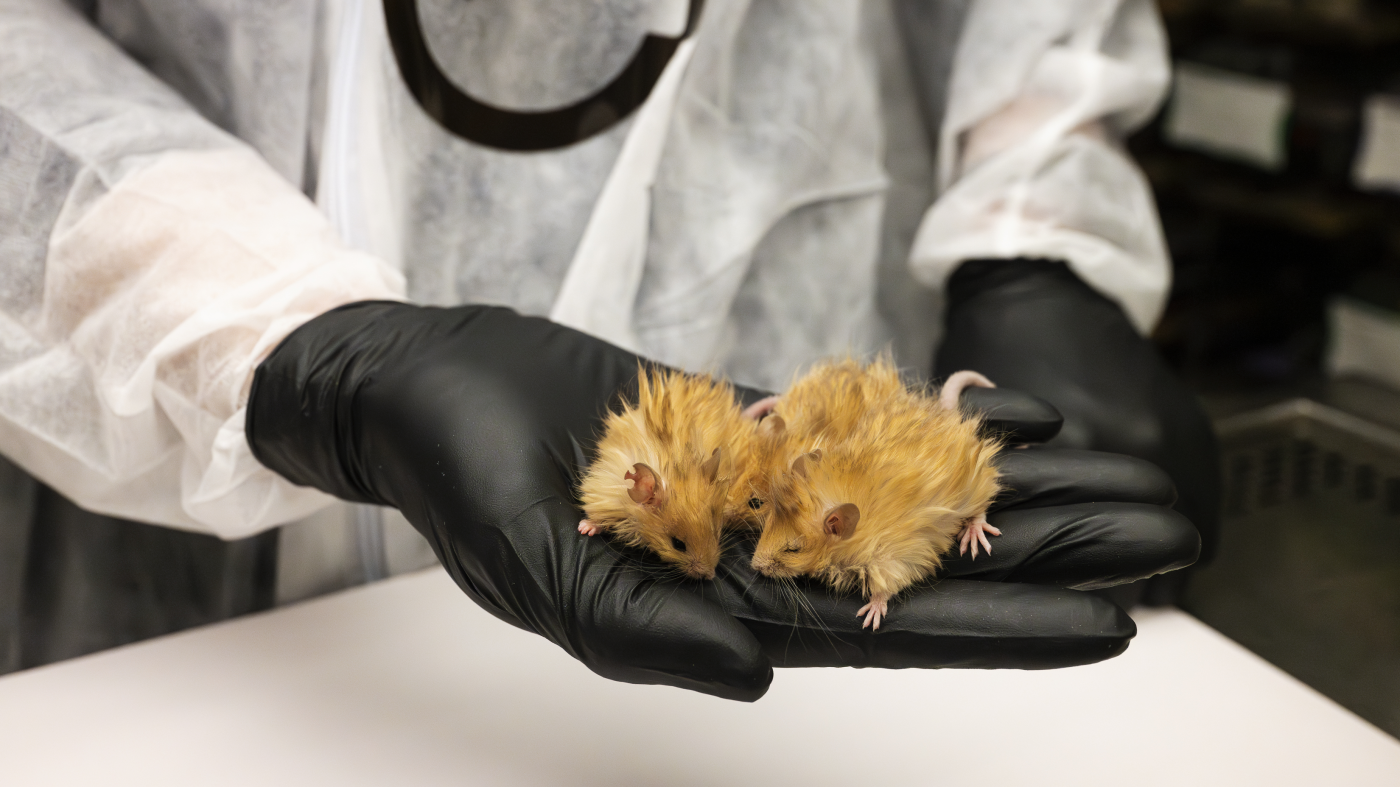
A woolly mouse, a breed created by scientists utilizing genetic engineering. The event is a primary step towards reviving a model of the extinct woolly mammoth.
Colossal Biosciences
disguise caption
toggle caption
Colossal Biosciences
Scientists have genetically engineered mice with some key traits of an extinct animal that was far bigger — the woolly mammoth.
This “woolly mouse” marks an essential step towards attaining the researchers’ final purpose — bringing a woolly mammoth-like creature again from extinction, they are saying.
“For us, it is an extremely large deal,” says Beth Shapiro, chief science officer at Colossal Biosciences, a Dallas firm attempting to resurrect the woolly mammoth and different extinct species.
The corporate introduced the creation of the woolly mice Tuesday in a information launch and posted a scientific paper on-line detailing the achievement. Scientists implanted genetically modified embryos in feminine lab mice that gave delivery to the primary of the woolly pups in October.
“That is actually validation that what we take note of for our longer-term de-extinction mission is admittedly going to work,” Shapiro instructed NPR in an interview. The corporate says reviving extinct species just like the mammoth, the dodo and others may assist restore ecosystems. Critics, nevertheless, query whether or not de-extinction can be protected for the animals or setting.
Shapiro and her colleagues began by attempting to determine the genes liable for making mammoths distinctive. They in contrast historical samples of genetic materials from mammoths with genetic sequences of African and Asian elephants, the mammoth’s closest dwelling relative.
These included lengthy, woolly hair and a approach of metabolizing fats that helped the animals survive properly within the chilly.
“After which we glance within the mouse for those self same genes and cases the place these genes have been concerned with making a woolly coat, or longer hair, or altering the colour of the hair,” Shapiro says.

One in every of Colossal’s wooly mice in comparison with an strange lab mouse.
Colossal Bioscience
disguise caption
toggle caption
Colossal Bioscience
The researchers used the newest genetic engineering strategies to make a mixture of modifications based mostly on what they discovered within the mammoth genomes and in mouse DNA within the hopes the modifications would produce the specified attributes within the offspring. And the experiment seems to have labored.
“We ended up with some completely cute mice which have longer, woolly, golden-colored coats,” Shapiro says.
The mice even have fats just like the mammoth, Colossal says, enabling them to outlive in chilly climate.
“That is thrilling to us as a result of it confirms that the genes and gene households that we recognized utilizing our comparative genomics strategy actually do trigger an animal to have a woolly coat and a golden coat and longer hairs,” Shapiro says. “And that is the best way that we will create mammoths for the longer term.”
They hope to try this by enhancing the genes within the embryos of Asian elephants and implanting the modified embryos into feminine elephants in order that they may give delivery to calves with the important thing traits that made the mammoths distinctive.
Different researchers say the woolly mice are thrilling.
“I am fairly skeptical about this, however that mouse is fairly cute,” says Vincent Lynch, a professor of biology on the College at Buffalo. “And for individuals like me who need to perceive the genetic foundation of traits, that is notably spectacular.”
However Lynch and others warning: A mouse isn’t an elephant. So who is aware of if they might do the identical factor with that species?
And even when they might, Lynch is amongst those that do not suppose bringing again the mammoth is a superb concept. The cash can be higher spent saving species on the point of extinction, critics say.
“The give attention to de-extinction or genome-modified organisms as a conservation device I consider is a distraction from the work that must be executed” to preserve species, says Gabriela Mastromonaco, senior director of wildlife science on the Toronto Zoo. “There’s species disappearing on daily basis.”
As well as, who is aware of what unintended penalties may end result from introducing herds of mammoth-like elephants into the Arctic?
“They form of need to fiddle on a pretty big scale,” says Karl Flessa, a professor of geosciences on the College of Arizona “I do not know what the draw back of getting a bunch of bushy Asian elephants stomping round within the tundra is perhaps. I do not know what would occur. They do not know what would occur. They cannot actually guarantee me that, ‘Oh, all the things will likely be simply fantastic. Every thing will likely be similar to it was again within the Pleistocene.’ I am not able to play God like that.”
For his or her half, Shapiro and her colleagues defend their mission. They are saying reintroducing mammoth-like creatures may gain advantage the setting by serving to restore ecosystems the place the mammoth as soon as lived.
“Our intention is to re-create these extinct species that performed actually essential roles in ecosystems which can be lacking as a result of they’ve turn into extinct,” Shapiro says.
As well as, the applied sciences the corporate is growing could possibly be used to attempt to defend dwelling species, says Ben Lamm, Colossal’s co-founder and CEO.
“Present conservation fashions work. They only do not work on the velocity at which we’re altering the planet and eradicating species,” Lamm says. “So we want new instruments and applied sciences so we will engineer life in a greater approach that is extra adaptable to be co-existent with people.”
Colossal hopes to supply mammoth-like Asian elephant embryos by subsequent yr and their first calves by 2028.
The corporate can also be engaged on bringing again the dodo chicken and the Tasmanian tiger.





